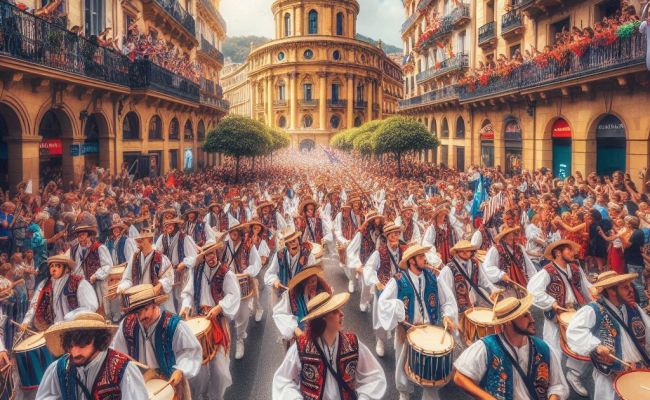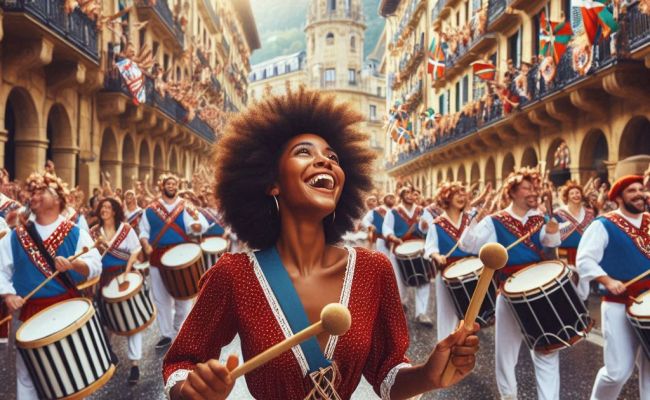The annual drum festival, Tamborrada of Donostia (Basque Donostiako Danborrada), takes place in San Sebastián, Spain, on January 20. At midnight, the mayor raises the San Sebastián flag atop the Konstituzio Plaza in the “Alde Zaharra/Parte Vieja” (Old Town). The festival runs for 24 hours. Participants dressed as cooks and soldiers march in formation throughout the city. At midnight, the event culminates with a gathering in the Konstituzio Plaza and the simultaneous lowering of the municipal flag in various locations.
Origin
During the nineteenth century, San Sebastián, a walled city, suffered severe damage from military engagements, most notably the Siege of San Sebastián in 1813, which involved Spain, France, Great Britain, and Portugal, with casualties varying from 7,000 to 50,000.
The celebration began in the 1830s when residents humorously replicated daily troop processions from San Telmo headquarters to the Main Gate with buckets and water pump hardware. This evolved into a forerunner to the Donostia Carnival, which began on January 20 and ended in early February with the Caldereros.
Initially, participants wore regular clothing to the Ox Run event on the same day. Vicente “Txiki” Buenechea provided drum barrels, which helped build momentum. In 1881, the Unión Artesana club in Tamborrada used leftover military clothes obtained in San Telmo. By 1886, they had incorporated barrels into their formations, and in subsequent years, additional gourmet groups joined to increase participation.
Legend has it that women drumming on basins joined a baker singing while fetching water during a 1720 drought, miraculously keeping the water flowing and establishing drumming as a symbol of prosperity.
Franco’s Carnival prohibition applied to both the Tamborrada’s cancellation in 1902 and its revival in 1906, as well as the Caldereros. The first Children’s Tamborrada was founded in 1927, and it became permanent in 1961. Since 1980, around 125 clubs have participated with mixed-gender bands.

Music
In 1861, local composer Raimundo Sarriegui created the event’s distinctive marches, notably the “March of San Sebastian” (110), which became popular. His other works include “Erretreta,” “Tatiago,” “Diana,” and “Iriyarena.” Recently, more parts have been added. Serafin Baroja, a local writer, penned the traditional lyrics for the marches.
In 2013, José Juan Santesteban added the ancient city march to the official songlist, commemorating the historic siege of 1813. The 1830s festivities featured the Old March.
Current celebration
During the “Noche de la Tamborrada” of the Tamborrada festival in San Sebastián, adults dine in gourmet clubs that were previously only open to men. They adore elegant seafood feasts and excellent wine. During the festival, mixed-gender drumming groups march through the streets, backed by marching bands. For locals, this is the most important event of the year.
Children participate in their own Tamborrada, dressed as Napoleonic troops from several countries. Originally held on festival day, it now begins days before, highlighting cultural heritage. The Children’s Tamborrada began in 1961 and incorporates schools throughout the city, with a repeat performance on festival day to honor city defenders.
WOMEN IN THE TAMBORRADA
This has been a contentious issue since the advent of women’s rights. Of the nearly 150 groups that engage in the Tamborrada, ten still do not allow women to join. Previously, more groups prohibited women from participating, but a growing movement has led to their acceptance as the norm. Previously, eating clubs, which serve as the foundation for drumming organizations, barred women from participation.
FAQ
WHY DO People CELEBRATE THE TAMBORRADA?
Essentially, it commemorates San Sebastián’s Day. Nowadays, it is a display of patriotism, or the closest thing to it, among the citizens of San Sebastián. It’s a source of pride. Joining a drumming group adds a significant value to your street cred; the closer you are to the Old Part and midnight on the 19th, the better. Everyone becomes emotional throughout the festivities, and the meal the night before is a big issue for many families. In fact, it is one of the only nights of the year when people indulge in premium shellfish, such as angulas or baby eels (elvers)
